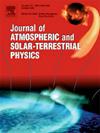水中放电时形成的对称粒子痕迹
IF 1.9
4区 地球科学
Q3 GEOCHEMISTRY & GEOPHYSICS
Journal of Atmospheric and Solar-Terrestrial Physics
Pub Date : 2025-07-28
DOI:10.1016/j.jastp.2025.106599
引用次数: 0
摘要
这篇论文研究了当电流脉冲通过碳酸氢钠溶液时形成的粒子痕迹。采用钢针电极作为阳极。在探测器(聚碳酸酯dvd)上发现了一组形状和大小完全相同的痕迹。走线厚度范围为1 ~ 10 μm。提出了这类粒子的结构模型。根据这个模型,粒子是以一组相同符号的离子的形式存在于极化水分子的壳层中的多电荷簇。计算这样一个集群中的力的平衡。结果表明,对于所有簇,电荷Q与其半径的平方之比A = Q/R2 = 1c /m2保持不变。分析了电场作用下这种团簇在空气中的运动。结果表明,具有相同参数A = Q/R2的簇在空气中以相同的速度运动。这使我们能够解释这样一个事实,即不同能量的粒子留下的不同厚度的痕迹具有相同的形状和大小。对多电荷团簇的电场能量进行了估计。已经证明它可以超过数百兆电子伏特。所得结果使我们有理由相信,在水中放电时产生的粒子结构可以用多电荷水团模型较为完整地表示出来。分析了一组同形迹形成的原因。它们可能是由直径1.6·10−6 m、电荷为6.31·10−13 c的粒子留下的。这些粒子极有可能是在液体内部正极附近形成的“母”团分裂成碎片的过程中出现的。本文章由计算机程序翻译,如有差异,请以英文原文为准。
Symmetrical traces of particles formed during electrical discharges in water
The paper studies traces of particles formed when an electric current pulse passes through a sodium bicarbonate solution. A steel needle electrode was used as an anode. Groups of traces of absolutely identical shape and size were detected on detectors (polycarbonate DVDs). The thickness of the traces ranged from 1 to 10 μm. A model of the structure of such particles is proposed. According to this model, a particle is a multiply charged cluster in the form of a group of ions of the same sign located inside a shell of polarized water molecules. The balance of forces in such a cluster is calculated. It is shown that for all clusters, the ratio of the charge Q to the square of its radius A = Q/R2 = 1 C/m2 remains constant. The motion of such clusters in air under the action of an electric field was analyzed. It is shown that clusters with the same parameter A = Q/R2 move in air with the same speed. This allows us to explain the fact that traces of different thicknesses left by particles with different energies have the same shape and size. The electric field energy of a multiply charged cluster has been estimated. It has been shown that it can exceed hundreds of megaelectronvolts. The results obtained give grounds to believe that the structure of particles generated in electric discharges in water can be fairly fully represented by the model of a multiply charged water cluster. The cause of the formation of a group of identically shaped traces has been analyzed. It has been shown that they could have been left by particles measuring 1.6·10−6 m with an electric charge of 6.31·10−13 C. It is highly likely that these particles appeared during the division into fragments of the “parent” cluster formed near the positive electrode inside the liquid.
求助全文
通过发布文献求助,成功后即可免费获取论文全文。
去求助
来源期刊

Journal of Atmospheric and Solar-Terrestrial Physics
地学-地球化学与地球物理
CiteScore
4.10
自引率
5.30%
发文量
95
审稿时长
6 months
期刊介绍:
The Journal of Atmospheric and Solar-Terrestrial Physics (JASTP) is an international journal concerned with the inter-disciplinary science of the Earth''s atmospheric and space environment, especially the highly varied and highly variable physical phenomena that occur in this natural laboratory and the processes that couple them.
The journal covers the physical processes operating in the troposphere, stratosphere, mesosphere, thermosphere, ionosphere, magnetosphere, the Sun, interplanetary medium, and heliosphere. Phenomena occurring in other "spheres", solar influences on climate, and supporting laboratory measurements are also considered. The journal deals especially with the coupling between the different regions.
Solar flares, coronal mass ejections, and other energetic events on the Sun create interesting and important perturbations in the near-Earth space environment. The physics of such "space weather" is central to the Journal of Atmospheric and Solar-Terrestrial Physics and the journal welcomes papers that lead in the direction of a predictive understanding of the coupled system. Regarding the upper atmosphere, the subjects of aeronomy, geomagnetism and geoelectricity, auroral phenomena, radio wave propagation, and plasma instabilities, are examples within the broad field of solar-terrestrial physics which emphasise the energy exchange between the solar wind, the magnetospheric and ionospheric plasmas, and the neutral gas. In the lower atmosphere, topics covered range from mesoscale to global scale dynamics, to atmospheric electricity, lightning and its effects, and to anthropogenic changes.
 求助内容:
求助内容: 应助结果提醒方式:
应助结果提醒方式:


